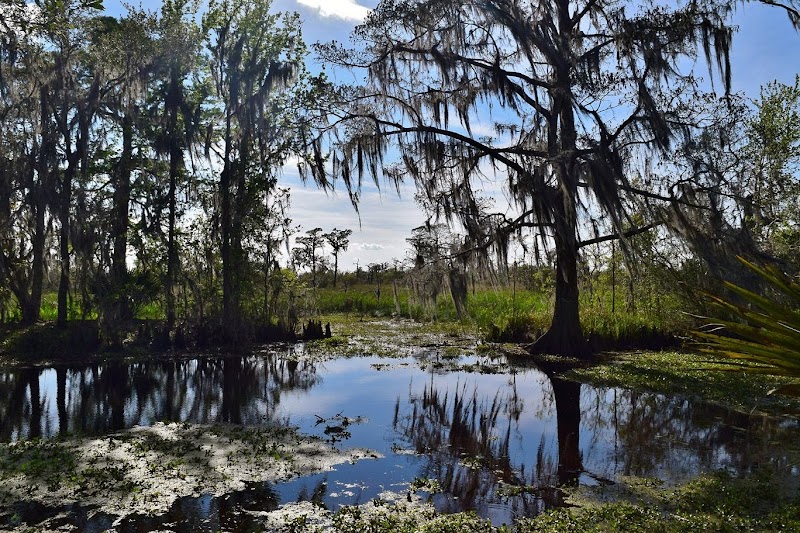
Tracking Wings: Exploring the Louisiana Birding Festival Near Thibodaux
The Louisiana Birding Festival near Thibodaux presents an active gateway into the state's wetlands, offering trails and waterways alive with diverse birdlife. Perfect for hikers and bird enthusiasts alike, the festival combines accessible routes with immersive nature encounters that challenge and inspire.
Hydrate Smartly
Carry at least two liters of water per person; the warm Louisiana climate and humid wetlands draw moisture out fast.
Wear Grippy Footwear
Choose boots or shoes with good traction to safely navigate muddy patches and slick wooden boardwalks.
Start Early
Begin hikes at dawn to enjoy cooler air and the most active birdwatching, avoiding midday heat and insect bursts.
Pack Binoculars and Field Guide
Bring binoculars and a local bird guide to enhance spotting and identification—crucial for the festival experience.
Tracking Wings: Exploring the Louisiana Birding Festival Near Thibodaux
Each spring, Napoleonville becomes the launchpad for one of Louisiana's most vivid outdoor experiences—the Louisiana Birding Festival. Just a short drive from Thibodaux, this event invites both casual nature lovers and seasoned birders to step into a living classroom where every wingbeat counts. Along the festival's trails and waterways, the landscape challenges you with flat to gently rolling terrain, primarily through swampy bayous, forest edges, and open marshes. These paths span distances from brief half-mile walks to more demanding 5-mile hikes that reveal the wetlands' fierce, untamed pulse.
The air hums with sharp calls and soft songs as birds claim their hemispheres, daring you to keep pace. Swallow-tailed kites hover above, wings slicing the sky like slow knives, while bright warblers flit through the dense cypress and tupelo forest. The marshes push back lightly underfoot, reminding you of the raw foundation beneath this ecosystem’s fragile beauty. Expect elevation gains to be minimal—often less than 100 feet—but note the soft, sometimes slippery footing on boardwalks and dirt paths.
Timing your visit is key: early morning hikes reward you with cooler temps and the full chorus of daybreak; midday brings a different rhythm as the sunlight crests and shaded paths become your refuge. Staying hydrated is essential—Louisiana heat seeps into your skin, transforming moisture into sweat with little mercy. Footwear with good grip and water resistance will keep you steady amid shifting textures beneath you.
With multiple guided walks, kayaking adventures, and expert talks framing the festival, the Louisiana Birding Festival is more than an outing—it’s an immersive dialogue with a living environment fiercely itself. This is a place where nature demands attention, teaches patience, and extends the invitation to witness survival and spectacle in equal measure. Whether you come for the thrill of spotting a rare sighting or simply to walk among the calls of the wild, this festival offers a chance to walk alongside a force that doesn’t bend—it welcomes you in its own terms.
Nearby Trips
All Adventures
Boat Charters
Water Activities
Adventures near Napoleonville, Louisiana
Discover the unique and memorable adventures that make Napoleonville, Louisiana special.
Frequently Asked Questions
What types of birds can I expect to see at the Louisiana Birding Festival?
The festival spotlights a vast diversity including swallow-tailed kites, painted buntings, various warblers during migration, waterfowl like ducks and geese in fall, and numerous wading birds such as herons and egrets year-round.
Are the trails wheelchair accessible?
Some sections, particularly around festival event sites and boardwalks, are made accessible, but most trails are natural terrain with muddy patches, making full accessibility limited.
Is kayaking part of the birding experience here?
Yes, guided kayaking trips are offered during the festival and provide a unique vantage point to observe birds and aquatic life up close along bayous and waterways.
What safety precautions should I take when hiking in the wetlands?
Watch footing carefully due to slick surfaces, use insect repellent, carry enough water, and check weather forecasts since sudden storms can occur. Follow marked trails and listen to guides to avoid sensitive habitats.
Are there any lesser-known spots in the area worth exploring during the festival?
Just outside main festival paths, smaller creeks and forest edges reveal quiet birding spots where rarer species like prothonotary warblers and secretive rails appear, offering rewarding solitude for patient hikers.
What cultural experiences are linked to the festival location?
The region carries deep Cajun and Creole heritage, reflected in local cuisine and music events tied to the festival. Many birding sites are near historic plantations and small towns where storytelling and tradition enrich the visit.
Recommended Gear
Water Bottle
Stay hydrated in Louisiana's heat; essential for every season but especially spring and summer.
Mosquito Repellent
Protect yourself from insects that thrive in the wetlands, especially during warmer months.
Waterproof Hiking Shoes
Wet and muddy conditions demand footwear that grips and keeps feet dry.
Binoculars
Enhance your birdwatching with close-up views of shy or distant species.
Local Insights
Hidden Gems
- "Quiet side trails through cypress groves reveal rare sight lines for woodpeckers and barred owls."
- "A small levee path offers wide-open views over marshes, perfect for watching migrating sandpipers with minimal crowds."
Wildlife
- "Swallow-tailed kites"
- "Prothonotary warblers"
- "Great blue herons"
- "American alligators (from a safe distance)"
History
"Napoleonville and surrounding areas reflect centuries of human interaction with wetlands, from early Native American settlements and plantation economies to modern-day conservation efforts protecting bird habitats."
